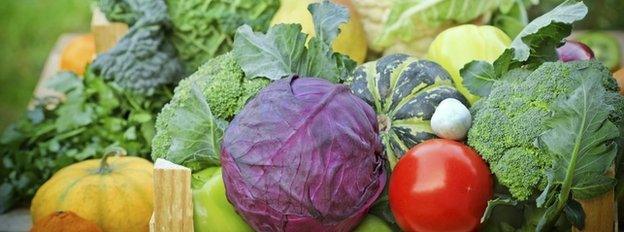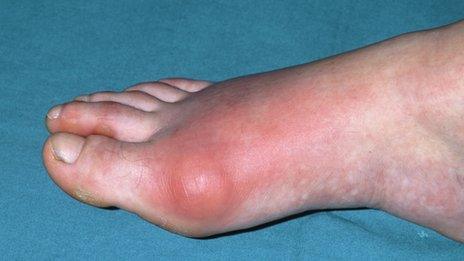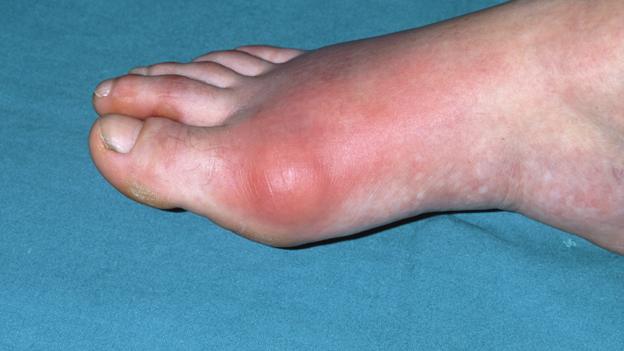Is scurvy making a comeback?
- Published

One large orange or a bowl of strawberries each day provides enough vitamin C for the body
Early explorers called it the "scourge of the sea" and the disease was widespread during the Victorian era, but could scurvy now be making a comeback?
Parents are constantly telling children to eat their greens and health experts urge us to make sure we eat our "five a day" - and with good reason.
Fruit and vegetables are important sources of vitamin C (also called ascorbic acid) which the body needs to keep our bones, skin, tissues and blood vessels healthy.
Without it, we lack a protein called collagen which can't be replaced and we end up with symptoms that were common hundreds of years ago in sick sailors and malnourished children.
The numbers are very small, but scurvy is on the rise in England, according to official figures from the Health and Social Care Information Centre, external.
In the year up to April 2014, it was the primary diagnosis behind 16 hospital admissions and the primary or secondary cause of 94 admissions.
Between 2009 and 2014, admissions related to scurvy went up by 27%.
That's in line with percentage increases in hospital admissions for malnutrition and gout - a common Victorian complaint traditionally associated with too much port and an unhealthy lifestyle - over the same period.
The most recent research, conducted in 2014, suggests that gout currently affects one in 40 people in the UK.
One of those unfortunates, the BBC's Richard Warry, explained his shock at being diagnosed with an extremely painful condition which is no laughing matter.


Where to find vitamin C?
in fruit such as oranges, lemons, limes, grapefruits, blackcurrants, strawberries, kiwi fruit and tomatoes
in vegetables like broccoli, asparagus, cabbage, green peppers, sprouts and sweet potatoes

What does this say about the nation's diet?
During the 18th century, it was dire - especially for sailors on long-distance voyages on the high seas. At that time, scurvy killed more British sailors than enemy action.
In the 1740s, a British voyage to the Pacific lost 1,300 men out of a 2,000-strong crew within 10 months of leaving port.
Richard Walter, the chaplain on the voyage, described the terrible suffering of the men, noting their ulcers, blackened skin, revolting gum disease and rotten breath.
When they got hold of the fruit they craved so badly, he described them swallowing it "with emotions of the most voluptuous luxury".

James Lind (1716-1794) showed that fruit in the diet would prevent scurvy
They had been used to eating a predominately salty diet, overdosing on seals' livers and fat.
They were, literally, dying for vitamin C.
When they reached land, it was celery, cabbage and plants which helped them recover. Future voyages carried dried vegetables, fruit and palm wine and sauerkraut to help ward off the dreaded scurvy and in 1752 a Scottish doctor, James Lind, found proof that citrus had a rapid beneficial effect.
Today, we are in a far better position thanks to improvements in standard of living and diet - but that doesn't mean there aren't pockets of people still at risk.
Fussy eaters
Lucy Jackman, a paediatric dietitian and spokesperson for the British Dietetic Association, says low-income families and those dependent on drugs or alcohol tend to the ones most often in that bracket.
"Scurvy results from a prolonged deficiency of vitamin C, which we get entirely from our diet, and it can make people really ill."
Warning signs of scurvy can include tiredness, muscle and joint pain and bleeding or swelling of the gums.
She says cases of scurvy are rare and isolated, but she does see very small numbers of children with vitamin C deficiency, which is generally related to "very fussy eating".
"The key is to catch it early, get the message across about balanced eating and to make sure they are eating five portions of fruit and vegetables every day."
An orange a day
Eating healthily doesn't have to be expensive, she says.
"Vitamins can come from a variety of sources. Although fresh fruit and vegetables are ideal, they can also be tinned or frozen, as long as they are varied."
Eating one large orange, a bowl of strawberries or a single kiwi fruit is enough to provide you with the vitamin C needed for your body every day.

How much vitamin C do we need?
babies need around 25mg of vitamin C a day
children 1-10 years old need around 30mg
children 11-14 years old need around 35mg
older children and adults need around 40mg (and more for those who smoke or drink large amounts of alcohol)
pregnant women need 50mg of vitamin C a day
breastfeeding mothers need around 70-75mg
Source: NHS Choices

While the increasing prevalence of gout in the UK is a concern, experts put it down to an ageing population and a growing obesity problem.
This painful and severe form of arthritis, which is caused by a build-up of uric acid in the body, can be managed through changes in lifestyle, like losing weight, eating less red meat and reducing alcohol intake.

Gout is a painful form of arthritis which is on the rise in the UK, affecting one in 40 people
Thanks to the childhood vaccination programme, many serious infectious diseases are a thing of the past.
But some common Victorian diseases still make an appearance on official hospital admission statistics, including cholera, typhoid fever, scarlet fever and rickets.
The cases may be rare, affecting the very young or the very old, but their presence reminds us that although time has moved on, poor diet can still be a cause of some serious illnesses.
- Published22 January 2016

- Published21 January 2016

- Published16 January 2014

- Published2 January 2014

- Published8 May 2013
